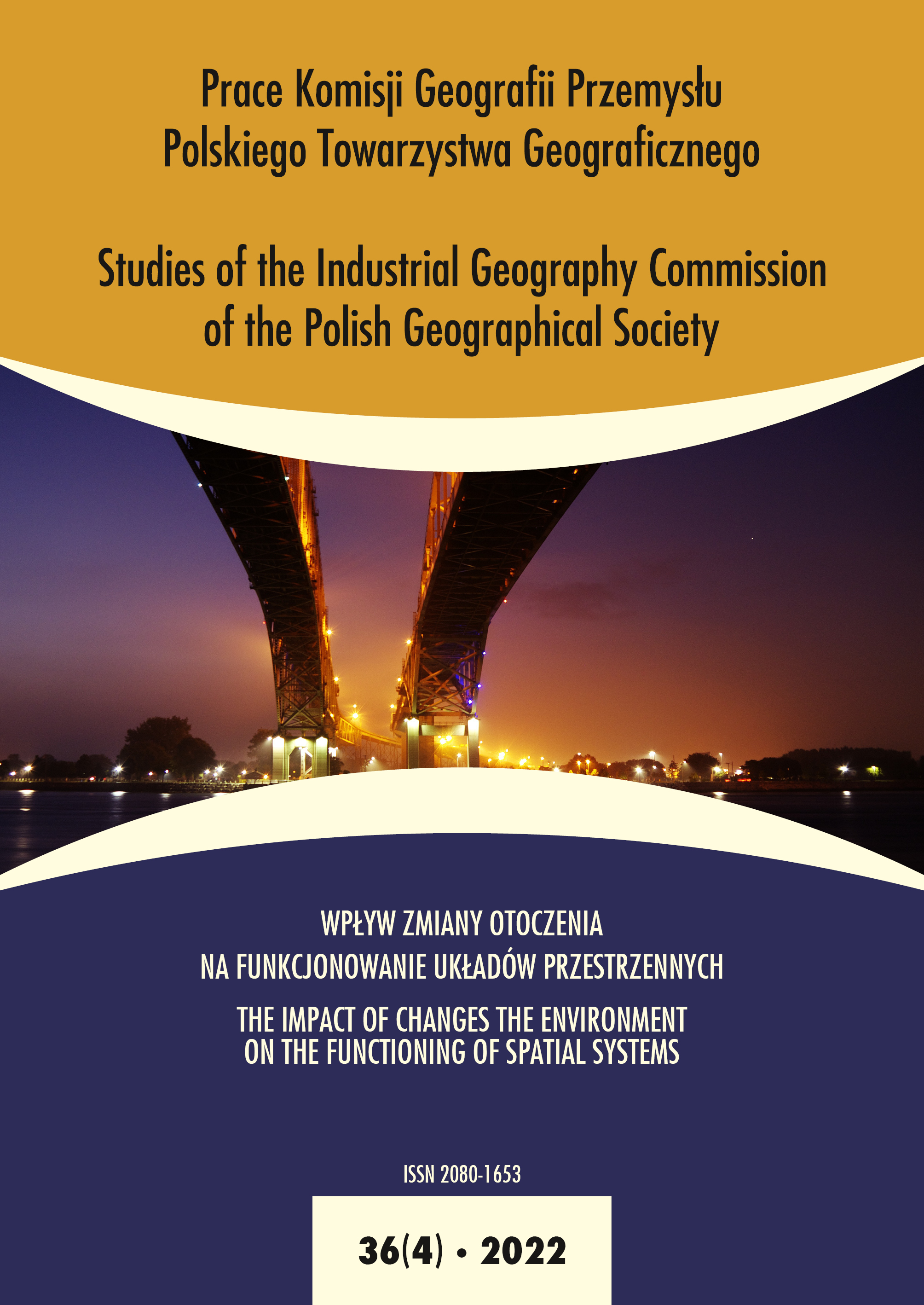Forms of cross-border cooperation based on the example of the Baltic commune of Heringsdorf (Germany) and Świnoujście (Poland)
DOI:
https://doi.org/10.24917/20801653.364.2Keywords:
border, cooperation, cross-border space, Heringsdorf, Świnoujście, translocal relationshipsAbstract
The article is part of the socio-economic analysis of the so-called Border Studies and concerns cross-border links and the processes of creating trans-local spaces. The main objective is to analyse various forms of cross-border cooperation, which as a result lead to the thickening of social, cultural and economic contacts between neighbouring communities on both sides of the border, and thus to the blurring of its formal character. The cross-border microregion on the Pomeranian Bay of the Baltic Sea, lying on both sides of the Polish-German border, consisting of neighbouring communes: Heringsdorf on the German side of the border and the commune of Świnoujście on the Polish side, was selected as the research object. The selected micro-region can be a characteristic example of the creation of transnational and translocal spaces, because as a result of integration treaties within the EU, the border has suddenly lost the power of an impenetrable barrier, and additionally, the attractive tourist location contributes to a more intensive functional link between the two communities. Based on a detailed empirical analysis of many recognised forms of cross-border cooperation, an attempt was made to systematise them in several spheres: economic, social, cultural and sports, and institutional. The study mainly used social research methods, i.e. field observation and in-depth interviews, as well as an analysis of official and media reporting documents.
Downloads
Metrics
References
Cerić, D., Więckowski, M. (2019). Współpraca transgraniczna w regionie Morza Bałtyckiego jako element kreowania przestrzeni turystycznej. W: A. Cedro (red.), Polska Geografia Morza. Przyrodnicze i społeczno-ekonomiczne badania morza i obszarów nadmorskich. Szczecin: Wydział Nauk o Ziemi Uniwersytetu Szczecińskiego, 29–45.
Dołzbłasz, S., Raczyk, A. (2015). Different borders – different cooperation? Transborder cooperation in Poland. Geographical Review, 105(3), 360–376.
Dołzbłasz, S., 2017. Sieci współpracy transgranicznej na pograniczach Polski. Wrocław: Instytut Geografii i Rozwoju Regionalnego, 40.
Greine, C., Sakdapolrak, P. (2013). Translocality. Concepts, Applications and Emerging Perspectives. Geography Compass, 7(5), 373–384.
Johnson, C., Jones, R., Passi, A., Amoore, L., Mountz, A., Salter, M., Rumford, C. (2011). Interventions on rethinking „the border” in border studies. Political Geography, 30(2), 61–69.
Kaczmarek, T., 1996. Zmienność struktur terytorialno-administracyjnych na obszarze przygranicznym. Biuletyn PAN KPZK, 171, 33–42.
Kaczmarek, T. (2003). Mała integracja – europejska współpraca miast i gmin. W: B. Breysach, A. Paszek. A. Tolle (red.) Grenze – Granica. Prace interdyscyplinarne o podobieństwach, barierach i horyzontach myślowych z perspektywy polsko- niemieckiej. Thematicon Wissenschaftliche Reihe des Collegium Polonicum, Band 8. Berlin: Logos Verlag, 142–152.
Kaczmarek, T., Stryjakiewicz, T. (2006). Grenzüberschreitende Entwicklungund Kooperation im deutsch – polnischen Grenzraumauspolnischer Sicht. Europa Regional, 14(2), 61–70.
Kolosov, V., Więckowski, M. (2018). Border changes in Central and Eastern Europe. Geographia Polonica, 91, 1, 5–16.
Kulczyńska, K., Matykowski, R., Tobolska, A. (2017). Informationsgewand als Ausdruck der Herausbildung transnationaler Räumen in benachbarten Grenzstädten. W: A. Tolle, R. Wehrhahn (red.), Transnationalität und lokale Raumproduktionen in transnationaler Perspektive. Thematicon Wissenschaftliche Reihe des Collegium Polonicum, Band 30. Berlin: Logos Verlag, 133–162.
Ossenbrügge, J. (1996). Oddziaływania gospodarcze i współpraca na niemiecko- polskim obszarze przygranicznym – perspektywa porównawcza. Biuletyn PAN KPZK, 171, 21–32.
Palmowski, T. (2000). Rola regionów transgranicznych w procesie integracji Europy Bałtyckiej. Gdańsk: Wydawnictwo Uniwersytetu Gdańskiego.
Palmowski, T. (2002). Współpraca transgraniczna obszarów nadmorskich na przykładzie Euroregionu Bałtyk. W: Euroregiony Wschodniego pogranicza – założenia i osiągnięcia. Białystok: Wydawnictwo Wyższej Szkoły Ekonomicznej w Białymstoku, 111–121.
Rumford, C. (2012). Towards a Multiperspecyival Study of Borders. Geopolitics, 17(4), 887–902.
Stryjakiewicz, T. (1996). Uwarunkowania polsko-niemieckiej współpracy przygranicznej na tle polityki regionalnej. Biuletyn PAN KPZK, 171, 7–20.
Studzienicki, T. (2016). The development of cross-border cooperation in EU macroregion – a case study of the Baltic Sea Region. Procedia Economics and Finance, 39, 235–241.
Szul, R. (2001). Uwarunkowania lokalnej współpracy transgranicznej. Polski Przegląd Dyplomatyczny, 1, 2(2), 89–98.
Teufel, N. (2014). The spatial production of a border-crossing civil society in Gorlitz and Zgorzelec. A German point of view. Bulletin of Geography. Socio-economic series, 25, 215–231.
Teufel, N. (2015). Von den Wunden der Geschichte zu den Laboren für das neue Europa?. Geographische Rundschau, 11, 10–17.
Tobolska, A. (2005). Świnoujście jako nadmorski i nadgraniczny ośrodek turystyczny. W: M. Dutkowski (red.), Zagospodarowanie przestrzenne i rozwój obszarów nadmorskich w Polsce. Szczecin: In Plus Oficyna, 74–77.
Tölle, A. (2010). Networking in a transnational cooperation space – the case of the Oder Partnership. Europa XXI, 20, 131–144.
Wehrhahn, R. (2015). Relationale Bevölkerungsgeographie. Geographische Rundschau, 4, 4–9.
Wehrhahn, R., Tölle, A. (2017). Translokalitat und lokale Raumproduktionen in transnationaler Perspektive. W: A. Tolle, R. Wehrhahn (red.), Transnationalität und lokale Raumproduktionen in transnationaler Perspektive. Thematicon Wissenschaftliche Reihe des Collegium Polonicum, Band 30, Berlin: Logos Verlag, 7–19. Statistisches Jahrbuch Mecklenburg-Vorpommern 2015. Pozyskano z: www.12._Gesamtausgabe (dostęp: 10 sierpnia 2019).
Urząd Statystyczny w Szczecinie. Pozyskano z: szczecin.stat.gov.pl (dostęp: 10 sierpnia 2019).
www.de.wikipedia.org/heringsdorf (dostęp: 10 sierpnia 2019).
www.edu-geography.com/cities/usedom.html (dostęp: 10 sierpnia 2019).
www.statistik-mv.de (dostęp: 10 sierpnia 2019).
www.swinoujscie.pl (dostęp: 10 sierpnia 2019).
Downloads
Published
How to Cite
Issue
Section
License
Copyright (c) 2022 Studies of the Industrial Geography Commission of the Polish Geographical Society

This work is licensed under a Creative Commons Attribution-NoDerivatives 4.0 International License.
Articles are published under the terms of the Creative Commons License (CC BY-ND 4.0; Attribution– NoDerivs).

